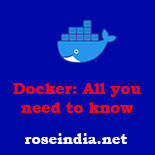Docker Service and Containers: All you need to know
Back in 2014, when Docker launched its Docker 1.0 which was capable of delivering software in the form of packages knows as containers, no one thought that it would have the same thunder that it has now.
The software company was founded by Sebastien Pahl and Solomon Hykes and was first made available to the public in 2013 at PyCon event. From there, the company never looked back and was set to release as a open source.
Such a rise in popularity is due to the fact that an increasing number of companies have started using Docker. As revealed by many statistical reports, more than 3.5 million applications have been set in containers by relying on Dockers. About 37 billion packed applications have been used and downloaded too.

As per 451 Research, its is being being predicted that "the application container market will explode over the next five years. Annual revenue is expected to increase by 4x, growing from $749 million in 2016 to more than $3.4 billion by 2021, representing a compound annual growth rate (CAGR) of 35 percent."
The growth has been so substantial for the software company that they witnessed a 40 per cent rise in market share. Thus, if companies like Microsoft and Oracle are using Docker then one surely knows that is shaking the tech world. Right now, almost every company belonging to the IT industry is embracing Docker.
One of the foremost reasons of Docker?s success is the fact that it makes use
of containers to operate. Since containers work by using connected operating
systems, it makes them much more proficient in comparison to hypervisors in
framework asset terms.
In other words, a container can store 4-6 times the number of applications than
by using technology like Xen or KVM VMs.
Another motivation behind why containers are famous is because they are capable of Continuous Integration/Continuous Deployment (CI/CD). This DevOps tech is intended to urge engineers to coordinate their code into a common vault early and regularly, and afterward to send the code rapidly and productively.
These containers also add a pros of portability. They are light weight and
can run on most technologies.
They can be converted to clouds too. As Ben Lloyd Pearson said "Docker has been
designed in a way that it can be incorporated into most DevOps applications,
including Puppet, Chef, Vagrant, and Ansible, or it can be used on its own to
manage development environments."
The software makes use of two tool out of which the first one is Docker Compose. By making use of YAML files, Docker Compose can operate on multi-container applications. Therefore tasks like creating images, measuring and running containers can be started and stopped on command easily.
The other tool used by the software is referred to as Docker Swarm. As the name suggests, this tool is used to control Swarm containers. Thus handling nodes in a swarm from listing to eliminating can be performed all thanks to this tool.
For its components, Docker makes use of its software, registries and objects.
It is all because of its efficient nature that Docker is worked closely with major tech companies like IBM, Huawei and Stratoscale which further helped fulfill the potential this software always promised.
Most of these software gradually do not live up to their hype or become less and less reliable for the tasks that are required to be completed in these modern times. It helps developers actually focus on their applications rather than giving emphasis on setting up the software. It is so easy that a developer can master it rather quickly that is in a few weeks time.

